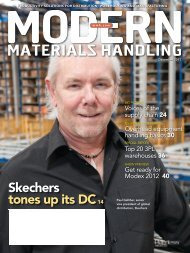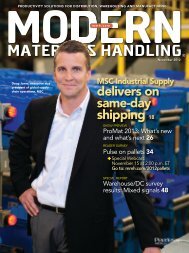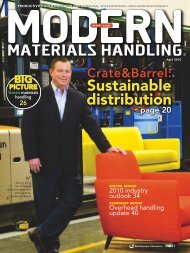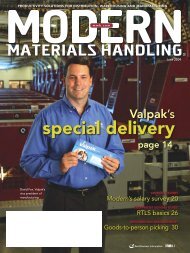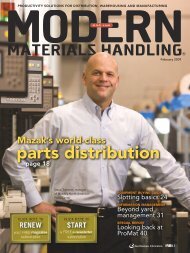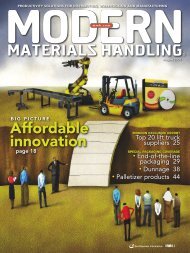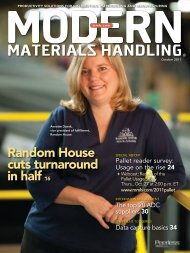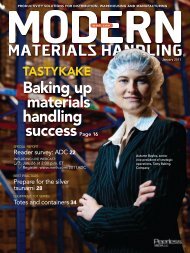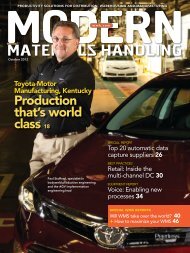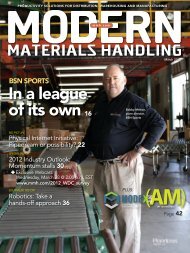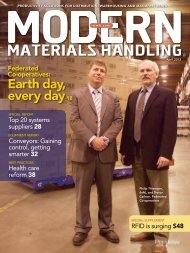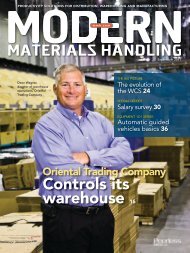Modern Materials Handling - April 2011
Modern Materials Handling - April 2011
Modern Materials Handling - April 2011
You also want an ePaper? Increase the reach of your titles
YUMPU automatically turns print PDFs into web optimized ePapers that Google loves.
modern system reportper day per employee in travel time thatwould now be available for value-addedprocesses or future growth. That was sufficientto justify the investment.Going live with roboticsMobile robotics was also an ideal technologyfor Otis Technology’s new leanmanufacturing strategy. In the old strategy,all of the materials for a day’s productionwere stored in a work center.Associates would retrieve the materialthey needed as they needed it. Keepingtrack of inventory in that system wasdifficult and it led to a lot of work. Onesolution was to allocate no more thanone hour’s worth of production materialsto a work center at any given time.Changeovers were easier, but thatapproach still required a lot of walking.As the team did the value-streammapping associated with lean, all thatwalking emerged as a significant waste.That’s where the mobile robots cameinto play. The machines operate likesmall automatic guided vehicles, shuttlingcontainers and totes rather thanpallets through the facility. That wouldeliminate the walking. What’s more,they could be easily reprogrammed ifproducts, processes or a layout changed.After performing due diligence, OtisTechnology executives ordered threemobile robots. The implementation andtraining took about a week.The primary function of the robots isto deliver kanban totes and containersfrom the AS/RS to work centers in themanufacturing area. In that capacity,when an item runs out in a work center,an associate on the line presses a callbutton for a mobile robot. When therobot arrives, the empty container, anywaste cardboard and a kanban card areplaced on one of the robots. The robotautomatically delivers these back to theAS/RS system.There, an associate scans a bar codeon a kanban card. That signals the AS/RS to retrieve and deliver the replenishmentitems. Meanwhile, the robotgets an opportunity charge. Once theproduct is delivered to the operator, it’sloaded onto the mobile robot and deliveredto a workstation.In addition, the robots are also usedto deliver work-in-process from workcenters to the AS/RS for temporarystorage; to deliver finished goods fromthe packing area to the AS/RS for temporarystorage; or from the line or theAS/RS to the shipping area.Employees have adapted well toworking with robots. “When we come upwith a new idea, we go through a changemanagement process,” York says. “Weexplain the benefits, explain how we’regoing to use it and we repeat that severaltimes. There’s a level of employee trustso that we don’t have pushback.”The biggest accommodation hasbeen to add audio to the robots so thatPallets and totes arestored in an AS/RS (center).Product is then packed inkanban totes and deliveredjust-in-time to the assemblyline (top).employees hear them coming. “Theaudio system plays music, and we allowthe employees to request what we playso long as it’s appropriate,” York says.Along with improved inventoryaccuracy and productivity, York saysthe most visible change may simplybe that the facility is orderly. “If youlook around, you’ll notice that there’sno inventory sitting in the aisles andonly the supervisors are walking,” hesays. “Our employees are all involved invalue-added services.”Down the road, he adds, if productsor processes change, there is aninfrastructure in place to adapt. “AllI’ll have to do is add another robot,”he says. “I have flexibility that I didn’thave before.” Mmmh.com <strong>Modern</strong> <strong>Materials</strong> <strong>Handling</strong> / A p r i l 2 0 1 1 19



